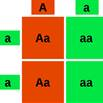![]()
![]()
![]()
Use LEFT and RIGHT arrow keys to navigate between flashcards;
Use UP and DOWN arrow keys to flip the card;
H to show hint;
A reads text to speech;
8 Cards in this Set
- Front
- Back
|
Genes; -occur in long strings called chromosomes -located inside the nucleus of every cell
Chromosomes; -made up of DNA molecules, which are - made up of 2 very long strands - coiled into a double helix
DNA; has a full set of instructions on how to; - how the cell should function - how the organism should be constructed
|
Genes are sections of DNA.
They control the development of different characteristics by issuing instructions to other cells. |
|
|
Chromosomes come in pairs and have the same sequence of gene, i.e. same genes same place
Animals have different numbers of pairs.
Humans have 23 chromosomes (46 in total) |
Sex cells contain single chromosomes. So instead of X- X it may be X-Y |
|
|
An allele is a gene with different versions.
for example the gene for dimples has 2 alleles.
For each gene you inherit one allele from each parent. |
It's possible to inherit two alleles that are the same.
this is Homozygous
on the other hand, you can inherit two alleles that are different.
this is Heterozygous
|
|
|
Genetic diagrams- Capital letters for dominant alleles and lower for recessive (minor) |

a Punnett Square |
|
|
One of the 23 pairs of Chromosomes in a human body cell is the sex chromosome.
|
In females the sex chromosomes are identical ( Both X)
In males they are different; an X and a Y chromosome. |
|
|
Genetic Diseases
Huntington's disease
its a dominant gene so the child only needs one parent with the Huntington's gene to get it
-A genetic disorder affecting the central nervous system. caused by a 'faulty' gene.
-Damages the brains nerve cells
-Causes gradual change, develop symptoms such as involuntary movement, clumsiness, memory loss and mood changes and inability to concentrate.
-Its incurable and leads to premature death
|
Cystic Fibrosis
Affects cell Membranes, causing a thick, sticky mucus especially in the gut, lungs and pancreas
Syptoms include weight loss, difficulty in breathing, chest infections.
Unlike huntingtons, cystic fibrosis is ressessive, so if only one person possesses one allele for CF they will have no symptoms of the disorder at all.
However these people are carriers and could pass them onto their children |
|
|
people use genetic testing to test a person for a faulty allele, to see if a foetus or adult possesses an disease causing allele.
the baby can be tested in the amniotic fluid. |
there are ethical concerns if a faulty allele is detected, eg, whether the pregnancy termination should be considered and the possible effects the information may have on an individual or their relationship. |
|
|
Embryo selection is another way of preventing babies from having genetic disorders.
these embryos are produced by IVF and reimplanted once the eggs have been testes for diseases, the ones that are disease free are implanted after cell division has taken place ( a single cell is removed and tested) |
B1 |

